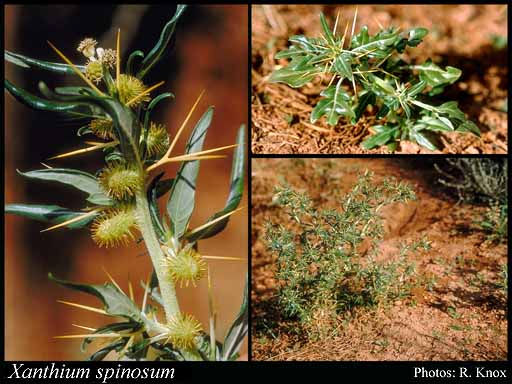- Reference
- Sp.Pl. [Linnaeus] 2:987 (1753)
- Conservation Code
- Not threatened
- Naturalised Status
- Alien to Western Australia
- Name Status
- Current
Coarse annual, herb, to 1 m high. Fl. Jan to Jun. Weed of disturbed & cultivated land.

Distribution
- IBRA Regions
- Avon Wheatbelt, Coolgardie, Great Victoria Desert, Jarrah Forest, Nullarbor, Swan Coastal Plain.
- IBRA Subregions
- Eastern Goldfield, Katanning, Merredin, Northern Jarrah Forest, Nullarbor Plain, Perth, Shield.
- IMCRA Regions
- Leeuwin-Naturaliste, WA South Coast.
- Local Government Areas (LGAs)
- Albany, Armadale, Cockburn, Fremantle, Kalgoorlie-Boulder, Melville, Menzies, Moora, Mundaring, Swan, Tammin, Wagin.
Management Notes (for the Swan NRM Region)
General Biology. Growth form. Herb. Life form. Annual. Reproduction. The burrs of Bathurst Burr. Dispersal. Hooked spines and attach readily to livestock, clothing. Also, dispersed by water.. Time of burrs produced. in February and continue bearing fruit for several months. Toxicity. Seed contains Hydroquinone. Seedbank persistence. May remain viable for up to eight years..
Notes. Bathurst Burr is an annual multi-stemmed herb to 1 m high. Its leaves are 20-80 mm long and 8-22 mm wide. The leaf margins may be entire or 3-lobed, occasionally 5 or more lobed. The upper leaf surface is dark green, prominently veined with 1 or 3 main whitish veins, while the lower surface is whitish and felted. Each leaf is armed on the stem with rigid 3-pronged spines at the base. Its flowers are unisexual with separate male and female flowers on the same plant. Male flowers are clustered at end of branches, or in the upper leaf axils while female heads are usually solitary in the leaf axils. Male flowers are pale or creamy green, often with blackish lobes, while the females flowers are yellowish green to brown The burrs are 10-12 mm long, with glandular and non-glandular hairs, numerous hooked spines, 2-3 mm long, and beaks 1-2 mm long..
Additional information. Origin. Native to South America.. History of use/introduction. Arrived in Australia in the 1840s, tangled in the tails of horses brought from America.. Similar native species. Xanthium strumarium, Xanthium spinosum.
Suggested method of management and control. Strong competition, particularly from a well managed pasture containing legumes, will greatly inhibit the successful establishment of Bathurst Burr. An integrated approach to managing Bathurst Burr should therefore be implemented which eliminates existing plants by spraying or grubbing then establishing competitive pasture to help prevent new plants from establishing. Eradication of Bathurst Burr requires the prevention of seeding for at least four to six years and the elimination of sources of reinfestation. Some seeds may remain viable for up to eight years. Small infestations are best dealt with by hoeing or grubbing the plants, then burning them. Plants carrying burrs should never be dumped, as the seed may be easily spread but should be gathered and burned. Removal by hand is not recommended due to the sharp spines. Repeated cultivation of seedlings after each germination event is effective on arable land. Mechanical slashing should be undertaken before the burrs have formed. An indigenous Australian Blight Fungus (Colletotrichum orbiculare) occurs on some infestations and is being developed by New South Wales Agriculture as a mycoherbicide. The accidentally introduced rust fungus (Puccinia xanthii) affects both Noogoora Burr and Bathurst Burr. The Bathurst Burr seed fly (Eurraresta bullans) was introduced from South America in the 1920s and affects large areas of burr in New South Wales and Queensland but provides no long term control. Bathurst Burr is susceptible to some herbicides, particularly on young plants. Spraying should be carried out before the burrs have formed. Pasture improvement combined with herbicide treatment is the favoured method of control in grazing lands. Read the manufacturers' labels and material safety data sheets before using herbicides. For further information consult the Australian Pesticides and Veterinary Medicines Authority to determine the status of permits for your situation or state.
Management Calendar
| Calendar Type | Jan | Feb | Mar | Apr | May | Jun | Jul | Aug | Sep | Oct | Nov | Dec | Comments |
|---|---|---|---|---|---|---|---|---|---|---|---|---|---|
| Germination | Y | Y | O | O | O | O | Y | Y | |||||
| Active Growth | Y | Y | O | O | O | O | Y | Y |
Legend: Y = Yes, regularly, O = Occasionally, U = Uncertain, referred by others but not confirmed.
References
- Australian Government (2019) Weeds in Australia . Commonwealth, Australia. URL: http://www.environment.gov.au/cgi-bin/biodiversity/invasive/weeds/weeddetails.pl?taxon_id=3714# - Accessed March 2019.
- Hussey, B.M.J., Keighery, G.J., Cousens, R.D., Dodd, J. & Lloyd, S.G. (1997) Western Weeds. A guide to the weeds of Western Australia. 1st Edition. The Plant Protection Society of Western Australia, Victoria Park.
- Parsons, W.T. & Cuthbertson, E.G. (2001) Noxious weeds of Australia. 2nd Edition. CSIRO Publishing, Collingwood.